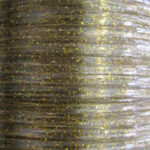

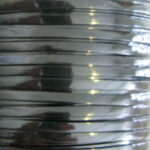

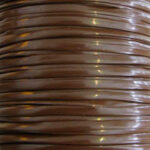
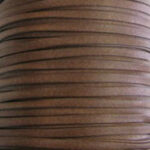
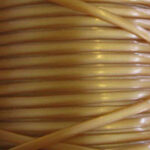
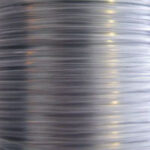
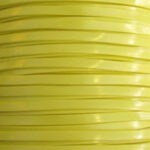
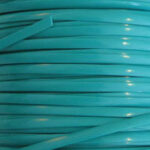
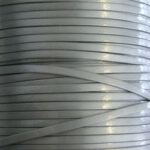
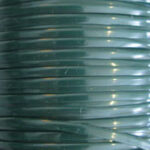
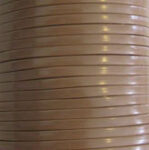
Authentic, vintage whipstitched fiberglass lampshades of the mid-century/modern era invariably used lanyard (aka “gimp” or “boondoggle”) to attach the lampshade parchment to the shade rings and frames. To maintain the authenticity of mid-century/modern design, Meteor Lights makes its lampshades and pendant shades the same way as the vintage shades were made, with whipstitched assembly. Lanyard is laced through small holes on the parchment edges and around the metal ring or frame support structure. A small knot is tied where the ends meet. Btw, cheaper knock-offs use 2″ centers, because it’s quicker and cheaper. We use 1″ centers, because it looks better and is more authentic. You’ll occasionally see 1/2″ centers on a rare ’50s lampshade. It looks too busy to our eye, and anyway life’s too short trying to lace those puppies up.
Why was lanyard used? Why aren’t fiberglass shades made the way conventional paper or fabric (cloth, linen, silk, etc.) shades made? On conventional fabric shades, the glued-on edge trim serve two purposes. First, trim is glued on to attach the shade material to the metal ring or frame support structure. Second, when paper or cloth is cut, the edges fray. Fiberglass parchment is a strong and durable material, and the edges don’t fray.
The fabricators of the original vintage 1940s and 1950s fiberglass lamp shades realized the edges wouldn’t fray, so there was no need to try to glue on extraneous and unnecessary edge trim. All that was needed was a way to affix the parchment to the support structure. The original manufacturers soon discovered that the fiberglass parchment was so strong that the parchment could be laced to the support structure through punched holes. Unlike paper and fabric shades, fiberglass parchment doesn’t deteriorate or crumple when punched and laced.
The lanyard on the original vintage retro shades was gut-coated fiber strands that eventually dried out, turned brittle, and broke off. Later laced parchment shades used plastic lanyard, a supple material that doesn’t dry out and fall off, leaving hardened ghost nubs of vintage lanyard poking out of the punched holes. Further, plastic lanyard is available in a much wider range of colors than the gut lanyard used on vintage shades. Meteor uses plastic lanyard on most of our shades, although we sometimes use rawhide or other similar materials upon request.
While almost everyone would agree that glowing, translucent fiberglass parchment makes a much better light diffusion material than opaque materials like paper (which is great for books, but isn’t really ideal for lighting), cloth (which is great for upholstery, but isn’t really ideal for lighting), or silk (which is great for clothing, but isn’t really ideal for lighting), some people still aren’t used to the look of lanyard on a shade. If this applies to you, we can help you get over your design anxiety: people are accustomed to seeing glued-on trim on a shade, simply because that’s how the majority of lamp shades are made, and the majority of shades are made that way because of manufacturing exigencies, and not because of any design imperative. There is no visual or industrial design imperative dictating that the perimeter metal shade ring has to be hidden beneath a layer of glued-on trim.
Glued-on trim is used on paper and cloth shades because 1. the fabric edges fray, and 2. paper and cloth are not strong enough to be punched and laced. Think about it: the metal spokes (i.e. shade “spider”) that connect the shade ring to the center washer, are always visible. So, seeing some of the metal structure apparently isn’t a problem. Conventional shades use glued-on trim not because there is anything wrong with seeing a metal ring, but simply because paper and fabric shades aren’t strong enough for mechanical fastening, i.e. lanyard laced through punched holes.
Aesthetics are derived from familiarity, what we’re used to seeing. Design resistance to lanyard owes to the visual familiarity that stems from the manufacturing imperative of inferior materials!
6 responses to “lanyard”
-
I am looking to purchase fiberglass parchment sheets.
-
We don’t sell the material at this time, but we may in the future…
-
-
do you sell the lanyard material? I have an mcm lamp with original shade but the lanyard appears to have been cut at some time in it’s past and not enough to tie back together.
-
At this time, we’re not selling lanyard or other shade-making supplies separately, but we may again in the future.
-
-
Looking for pendants in my bedroom, do you have any pictures of pairs?
-
Here are some examples of pendant lamps, but at the moment, I can’t find a specific photo of a bedroom pair in my catalog of thousands of photos…
-
Please use the comments form for, well, comments, as well as general questions, suggestions, reminiscences, recipes, and camping tips. Please email us directly ( store(AT)meteorlights.com ) if you have specific questions.

Leave a Reply